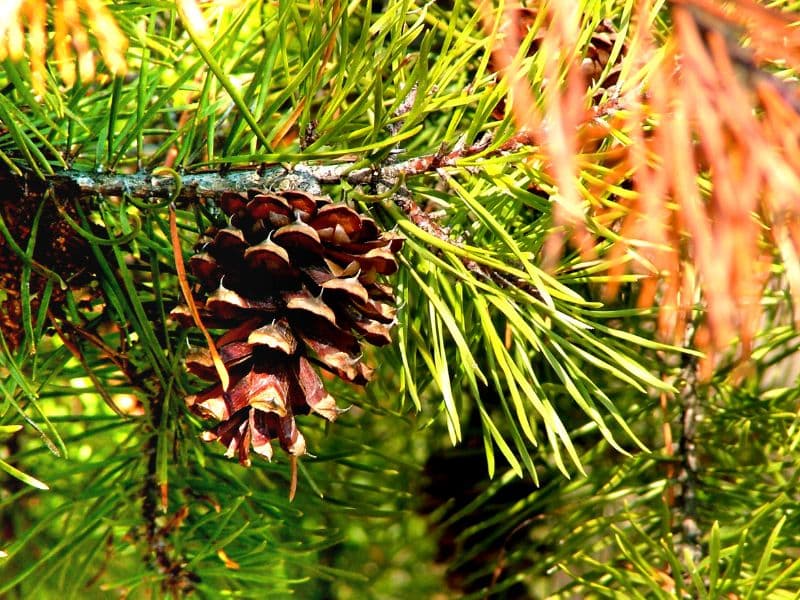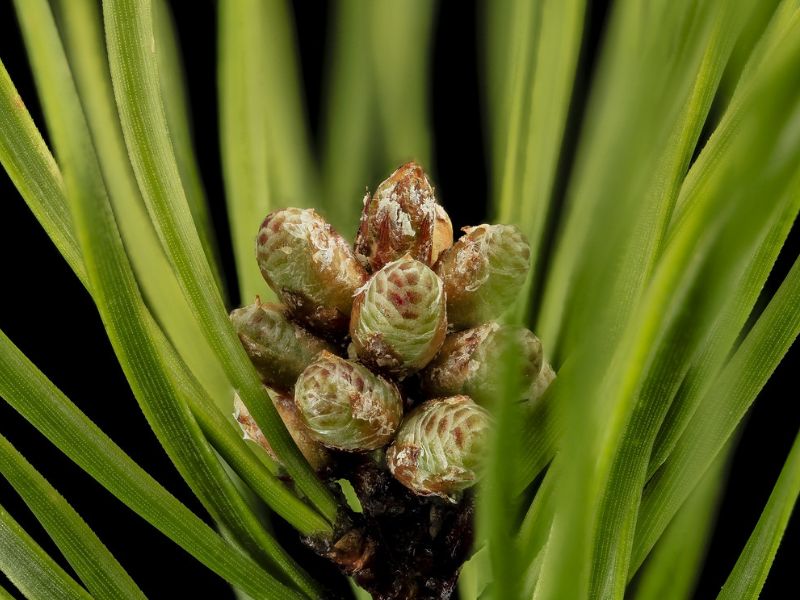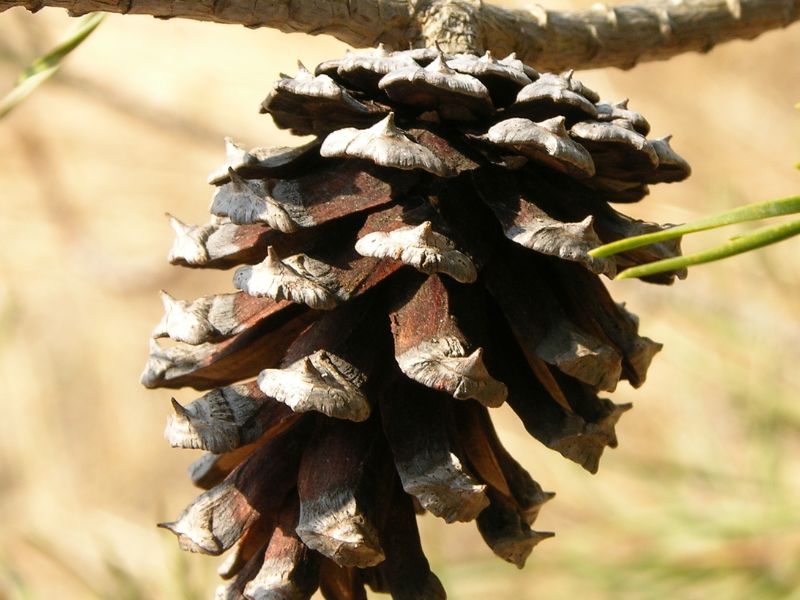The Virginia pine is not considered a landscape tree due to its unruly growth and rugged character, but it is an excellent specimen for naturalizing large spaces, reforesting, and providing habitat and food for animals and birds. Growing Virginia pine trees has become useful for taking over vacant land, which they colonize for 75 years or so before new tree species become dominant. Read on for more Virginia pine tree information and see if this plant is right for your needs.
I. Appearance and Characteristics
Pinus virginiana, the Virginia pine, scrub pine, Jersey pine, possum pine, is a medium-sized tree, often found on poorer soils from Long Island in southern New York south through the Appalachian Mountains to western Tennessee and Alabama.
Pinus virginiana is endemic to the United States and can be identified by a key characteristic; the relatively short needles are twisted and come in bunches of two. The needles are typically two to eight centimeters in length. There is hair on the bracts and on the bud scales of the P. virginiana. The leaf sheath of the P. virginiana is greater than 2.5 millimeters long. The cones of the P. virginiana only open after they are mature. The branches of the Pinus virginiana are flexible. They will bend when pressure is added to them. Pinus virginiana are between 9 and 18 meters tall.

The bark of P. virginiana is red and brown in color, and also has the tendency to be rough with relatively small bark scales. The pollen cones are circular, almost elliptical and are 10–20 millimeters in size. They are the same color as the bark, typically. Seed cones are spread throughout the tree. The mature seed cones (4–7 cm) are much larger than the pollen cones. The P. virginiana prefers to grow in poor soils and dry loam or clay. They can grow on sandy soil, but this usually causes the tree to be smaller than the average P. virginiana.
Pinus virginiana inhabit dry forested areas. The tree occurs in New York, New Jersey, Pennsylvania, Virginia, West Virginia, Ohio, Illinois, Kentucky, Tennessee, North Carolina, Georgia, Alabama, Mississippi, Indiana, South Carolina, Maryland and Delaware. In locations where the P. virginiana lives, rainfall is typically between 890 and 1400 millimeters. The average temperatures in the summer are between 21–24 degrees Celsius and in the winter it is around −4 to 4 degrees Celsius.
Pinus virginiana is poorly adapted to fire, but if the tree is larger they are able to survive. Open growth Virginia pines may begin cone production at only 5 years old. There have been documented cases of trees as young as 18 months beginning to flower. Virginia pine is monecious and some self-pollination is possible, but a significant seed crop requires two trees. Cones take two complete growing seasons to develop. Pollination takes place 13 months after cone formation begins, and dispersal occurs the following autumn. Unlike some other pines, Virginia pine produces cones in all parts of the canopy. Pinus virginiana is reportedly naturalized in southern Ontario.

| Common name | Jersey Pine, Possum Pine, Scrub Pine, Spruce Pine, Virginia Pine |
| Botanical name | Pinus virginiana |
| Family | Pinaceae |
| Species | virginiana |
| Origin | USA, higher elevations on the eastern portion of the country |
| Life cycle | Woody |
| Plant type | Native Plant |
| Hardiness zone | 4, 5, 6, 7, 8 |
| Sunlight | Full Sun |
| Soil condition | Clay |
| Soil ph | Acid |
| Drainage | Well-Drained |
| Growth rate | Slow |
| Spacing | 12 – 24 ft. |
| Harvest time | Fall |
| Flowering period | Spring |
| Height | 4- 80 ft. |
| Width | 4- 80 ft. |
| Flower color | Gold, Yellow |
| Leaf color | Gold, Yellow |
| Fruit color | Gold, Yellow |
| Fruit benefit | Showy |
| Garden style | Native Garden |
| Uses | Woodland |
II. How to Grow and Care
Sunlight
The virginia pine can grow in both full sun and partial shade. When placed in a well-ventilated location with sufficient sunlight, the needles will be green and strong. In a hot location with insufficient sunlight, the needles will be weak and will easily turn yellow. Ideally, the plant needs around 5-6 hours of sunlight a day, with good ventilation.
Watering
For newly planted seedlings or new plants, water once every morning and evening during hot spells in the summer. Do not water midday, as this can cause root burn or strangle. Water plants according to your individual climate and rainfall in other seasons. For mature plants, only water when they are dry, keeping in mind that these plants are drought resistant. For indoor potted plants, spray water on the surfaces of the leaves once every morning and evening when it is dry. Be careful not to provide excess water – this hinders air circulation in a pot, leading to the rotting of roots and the withering of branches and leaves.
Soil
Virginia pine can grow in a variety of different soil types, including bare mineral soil, sandy soil, volcanic ash, calcareous soil, limestone soil, and everything from dusty soil to red soil. Since it is resistant to drought, it will even grow in barren landscapes. However, it grows best in loose, fertile, well-drained, and slightly acidic soil. In the case of too much alkalinity, needles of potted plants will turn yellow and fall, so it is best to use natural mountain soil in pots and containers.
Fertilizing

The virginia pine likes fertilizer and should be fertilized frequently, with just a small amount each time, during its growth period. It should be fertilized once a month in late spring, early summer, and fall. A fermented organic fertilizer is most effective for promoting growth.
Generally, do not apply a nitrogen fertilizer, such as urea or human urine, because pine needles already absorb nitrogen from the air, and pine roots are sensitive to nitrogen. You would be best off with a liquid fertilizer, applying this when the soil is dry in the afternoon. Water the plant again after fertilizer application, which will help with root absorption.
Do not use fertilizers that haven’t been fermented, or those with a higher concentration; the former will burn the roots and the latter will lead to the spindling of needles and more root damage, and could even cause the back-flow of sap, leading to water loss and the withering of the plant. No fertilizer should be applied in midsummer, during severe winters, or in the rainy season in the spring.
Generally, plants in gardens should be fertilized twice during the growth periods in spring and fall. Apply an organic fertilizer once before germination in the spring and apply slightly more fertilizer in the fall to promote robust growth. Stop fertilizing after midsummer so as to prevent spindling.
Planting Instructions
Virginia pine is best planted in early spring. Ideally, use healthy and vigorous seedlings with soil balls, as this can greatly improve the survival rate. In the case of many lateral roots, the deep main root can be cut. Otherwise, the root system should be protected to avoid damage.
Plant in a high, dry, well-drained, and well-ventilated place, with loose soil. In low-lying places with accumulated water, or places with sticky soil, try building a platform or changing the soil before planting. The planting pit should be treated with a basal fertilizer before planting. Newly planted large seedlings should be supported to prevent them being blown down by the wind. Before planting, excess branches should be pruned off.
Protect the plant’s shape from damage as much as possible, as this will help to restore growth at a later stage.
Ideally, plant indoor potted plants in the spring, and repot every two or three years in the late fall or early spring. Repotting too frequently will lead to the death of the plant. If the plant is growing weakly, find out the cause of this and change the flowerpot soil, or replant in a larger pot.
Cut back on water before repotting, so as to keep the soil slightly dry. Remove the soil ball from the pot, keeping it whole, and then prune away any old roots from the bottom and sides. Remove some of the old soil from the middle of the soil ball, replace with new soil, apply a small amount of basal fertilizer, and then cover the plant with new soil. Ensure a suitable pot size – a deep pot will easily accumulate water, leading to root rot.
Pruning
For an indoor potted plant, any dead, diseased or damaged branches should be removed. You can then adjust the tree’s shape by pruning branches, pinching buds, and trimming leaves, giving you a better ornamental effect. Prune the plant before all of its needles fall off, so as to obtain a compact shape, richer lateral and side branches, and a better form overall. Pruning should be done during the dormancy period, so as to prevent excess loss of sap and damage to the plant’s vigor.

For a plant in a garden, dense lateral branches should be pruned so as to improve the survival rate. Remove excess lateral branches during the vigorous growth period based on needs, focusing on encouraging the trunk to grow tall and straight. Cut off any diseased or dead branches right away, so as to prevent the spread of pathogens.
Propagation
Propagating a Virginia pine tree should be done from cuttings taken between fall and winter before the new spring growth. You’ll need patience, however, because rooting a Virginia pine can take at least a year to root properly.
- Take a few 4- to 6-inch cuttings from branches with healthy growth at the tips. Remove needles from the cutting’s lower third.
- Dip the bottom inch of each cutting into the rooting hormone.
- Plant each cutting in a small pot filled with a mix of potting soil, perlite, and coarse sand for good aeration. Make sure no needles are touching the soil when inserting the cutting into the pot.
- Water the soil until it’s moist but not soggy.
- Cover the pot with clear plastic for a greenhouse effect.
- Place in bright, but indirect sunlight and keep the soil moist.
- Remove the plastic as soon as new growth appears.
- Allow the seedlings to grow enough before transplanting outdoors in the early spring so they can become successfully established.
- Plant seedlings outdoors in a clean site without any competing vegetation nearby.
Potting and Repotting
Virginia pine tree is a large tree that is not suitable for container growing.
Overwintering
As a native tree, Virginia pine is very hardy and does not need any winter protection.
Pests and Diseases

- Common Pests & Plant Diseases
Despite it being a native tree, Virginia pine can have a wide range of pest and disease problems. It can be attacked by pinewood nematodes, sawflies, pine beetles, and weevils.
The tree can also develop Diplodia tip blight, heart rot, and pitch canker, all of which may need professional intervention to stop the infection of adjacent trees. Sometimes applying fungicides in the spring or pruning infected branches and twigs during dry weather can prevent the spread of the disease.
- Common Problems
The shape and size, combined with the tree’s notoriously weak wood that breaks with ease in windy conditions, means it is a poor choice for most ornamental landscape uses, and it is not often chosen for that purpose.
III. Uses and Benefits
This pine is useful for reforesting and provides nourishment for wildlife. Its other main use is on Christmas tree farms, despite having sharp-tipped needles and yellowish winter color.

Cherokee Native Americans used P. virginiana medicinally. They used it for many symptoms like diarrhea, stiffness of the body, colds, fevers, hemorrhoids, tuberculosis, and constipation. Cherokee Indians used P. virginiana in different ways including bathing in water that had been soaked in the bark, steams and oils, root and needle infusions, and for tar. They also used it in certain cultural rituals. In burial rituals P. virginiana branches were burned and the ashes were used for a fire in their homes. Also, they would infuse needles in apple juice and they would drink it. The Cherokee basically did that as a toast to the wind. Lastly, they used the root infusions as a stimulant and the needles were used as a soap.
Pinus virginiana was used historically as mine timbers, for railroad ties, and for fuel and tar. Currently, it is being planted as in reclamation sites for coal mining operations. Pinus virginiana can also be used for wood pulp, which is used to make paper, and for lumber. The wood weighs 32 pounds (14 kg) per foot.






